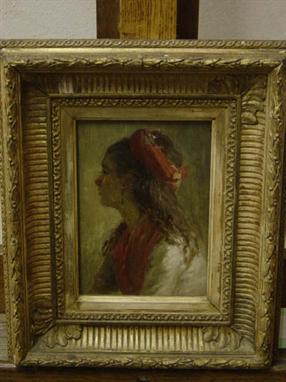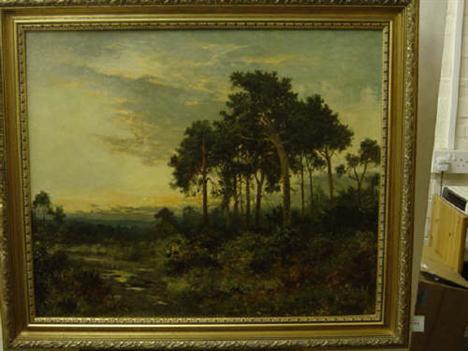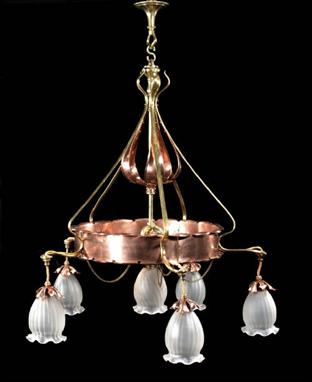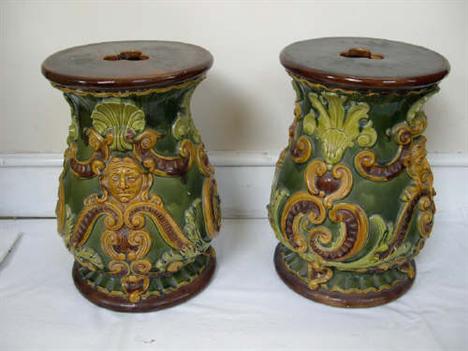We found 534325 price guide item(s) matching your search
There are 534325 lots that match your search criteria. Subscribe now to get instant access to the full price guide service.
Click here to subscribe- List
- Grid
-
534325 item(s)/page
JOHN ABSOLON (1815-1895) GREETING; PASTORAL CONVERSATION; REFRESHMENT (ILLUSTRATIONS FOR "THE VICAR OF WAKEFIELD") Three, each signed and dated 1846, watercolour and pencil vignettes Each 17.5 x 22.5cm. (3) Exhibited: The Fine Art Society Ltd, November 1968 ++ Each in need of a light clean; some foxing
THOMAS LANDSEER, ARA (1795-1880) STUDY OF A HOUND Signed, soft pencil drawing, heightened with white chalk 18.5 x 27.5cm. Provenance: A letter verso indicates that this drawing was a gift from W. D. Edmonston of Colorado to his friend Dr. H. K. Carter on March 17th 1908 "as a slight token of my regard and remembrance of the pleasant evening spent at your home". ++ Slight handling creases; light staining
An Art Deco glass and silvered bronze table lamp by Jacques Adnet for Baccarat 1930s the glass sphere sitting on a stepped circular base 18.5cm. high (incl. light fitting) A pair of this type sold at Sotheby's New Bond Street Fine Decorative Arts & Design from 1870 22nd September 2005 lot 124.
'Gianno Bifronte': A painted perspex panel of two faces by Gio Ponti 1970s acrylic and gouache on perspex framed signed 'G.P.' to the front and 'Gio Ponti' to the reverse 60cm. high by 70cm. wide (approx.) Provenance Gio Ponti's family home Ponti's daughter Giovanna Rosselli Ponti Galleria Blanchaert Milan Present vendor Literature To see other examples in situ see: Ugo La Pietra Gio Ponti Milan 1995 figs. 494-496. Another acrylic portrait on perspex dating to 1977 is illustrated fig. 810. This and the following lot are painted on perspex and are designed to be hung in front of windows allowing light to shine through the works. Ponti designed these 'decorated windows' to give proportion to a room alleviate the monotony of a glass wall and also to provide a change in effect as external conditions vary between day and night. Sold together with a certificate of authenticity signed by Giovanna Rosselli Ponti and dated 14 May 1999.
A walnut corner desk by Alfred Waterhouse 1872-73 of semi-octagonal free standing form with a panelled reverse with an inset tooled leather writing surface flanked by two frieze drawers the turned legs joined by an undertier on brass casters 110cm. high by 165cm. wide by 92cm. deep Exhibited Architect - Designers Pugin to Mackintosh exhibition catalogue May 1981 The Fine Art Society Ltd. with Haslam & Whiteway Ltd. pp. 24-25. Literature Stuart Allen Smith 'Alfred Waterhouse Civic Grandeur' in: Jane Fawcett (ed.) Seven Victorian Architects Hampshire 1974 pp. 92ff for an extensive essay on Waterhouse and his life and work. Colin Cunningham and Prudence Waterhouse Alfred Waterhouse 1930 - 1905 Biography of a Practice Oxford 1992 pp. 23 146 224. Waterhouse was commissioned to turn Blackmoor Farm House in Hampshire into a mansion by supplying designs for functional buildings and furniture which he carried out between 1866-73. He employed Henry Capel in the Blackmoor project knowing that he could rely on his hi h standards. Although a dedicated reader of Pugin's and Ruskin's writings and producing many study sketches of their work Waterhouse never hesitated to embellish his Gothic designs with features from other historic styles and hence developed a distinct architectural language. He studied the historic styles during his 'Grand Tour' through Europe (1853-54) and was excited about the variety of possibilities. He remarked very poignantly: "Returned home much disgusted with English architecture. We want size light and shade and colour in our buildings - and in ourselves more good humour and good manners - cost of journey £11.6.1.5." W
An Aesthetic Movement carved oak sideboard after the design by Bruce Talbert circa 1885 the rear superstructure with carved portrait roundels and embossed leather panels below the inscription 'God's Providence is Mine Inheritance' the lower section with a carved panelled frieze drawer flanked by cupboard doors 170cm. high by 206cm. wide by 66cm. deep The design of the present sideboard is related to the famous 'Pet' sideboard designed by Bruce J. Talbert and executed by Gillow & Co. for the 1871 International Exhibition in South Kensington. For the exhibition the original light oak sideboard with boxwood carvings was shown within a complete room setting '...intended to suggest the treatment of a Dining Room in the later English style...'. The Exhibition sideboard was afterwards bought by the South Kensington Museum now the Victoria & Albert Museum. It numbers among several remarkable and prize-winning exhibition pieces designed by Talbert including the 'Pericles' sideboard exhibited by Holland and Sons in Paris in 1867 and the 'Juno' cabinet shown by Jackson & Graham in Paris in 1878 the latter also in the collection of the V&A in London. The design for the present sideboard is illustrated in Talbert's second book Examples of Ancient and Modern Furniture published in 1876.. W
An Arts & Crafts three light chandelier by W.A.S. Benson circa 1900 brass and copper with a Powell opalescent glass shades ceiling rose stamped 'Patent' 60cm. high (approx.) Literature A similar example illustrated in: Ian Hamerton (ed.) W.A.S. Benson Arts and Crafts Luminary and Pioneer of Modern Design China 2005 p.257 pl.5. W
A pair of three light wall appliques by W.A.S. Benson circa 1900 each with three brass arms with copper foliate decoration suspending a stylised floral light fixture 40cm. high (approx.) (2) Literature illustrated in: Ian Hamerton (ed.) W.A.S. Benson Arts and Crafts Luminary and Pioneer of Modern Design China 2005 p.258 pl.11.
A Victorian diamond Knight Grand Commander Order of The Star of India decoration centrally set with a hardstone cameo depicting the profile of Queen Victoria to a pale blue enamel ground bearing the motto ‘Heaven’s light our guide’ to a surmount set with cushion shaped old brilliant cut diamonds beneath a similarly set star motif mounted in gold backed silver. . The Order of the Star Of India was established in 1861 to recognise Imperial service in the Indian Empire and it was discontinued in 1947
A Hardy Graphite ‘Stillwater’ 10ft #7/8 two piece fly rod in original blue cloth rod bag a Bruce and Walker Mark I Ultra Light #8 9ft 4 inch two piece carbon fly rod in original blue cloth rod bag A Shakespeare ‘Worcestershire Fly’ Boron 1727-420 #10/11 14ft three piece carbon fly rod in original red cloth rod bag and an Abu 81 Svangsta 6ft two piece carbon spinning rod (4)
Approximately 160 paper cased cartridges including an E. Casciano ‘Light Sporting’ A Purdey’s Special a J. Dickson & Son Edinburgh a Yellow Seal Mullerite a Henry Atkin Ltd ‘The Covert’ and a W.C. Carswell Ltd (This lot will only be released to holders of either an R.F.D. or shotgun certificate)
A 3 1/2in gauge model of ‘Juliet’ 0-4-0 tank locomotive with copper boiler and fittings including water and pressure gauges safety whistle clack valve and blow down plug. Chassis details include twin outside cylinders 1in bore by 1 1/2in stroke eccentric valve gear cab controls including regulator sight glass pressure gauge ratchet oiler and other usual fittings. The locomotive is finished in light green and black livery with polished brass and brightwork. 51cm long.
J Potter East end' Cart Another example of J Potter's skill as an East End cart maker, this example was apparently restored with the accompanying Governess cart a number of years ago. Painted in blue with light blue coach lining, its desirability lies in its forward-facing driving position. A pair of lamps and a stand complete the outfit
1931 Rolls-Royce 20/25hp Sedanca de Ville Coachwork by Park Ward & Co Registration Number: LGY 665 Chassis Number: GFT 72 Engine Number: S7Q Launched in 1929, the 20/25 followed established small' Rolls-Royce practice in that it was conceived and built to the same exacting standards as its larger Phantom II stable mate. The 20/25 quickly drew praise from the contemporary press, Autocar noting that it had great refinement of power, and a gentleness and quietness in doing its work, which makes results deceptive. Sedanca de Ville coachwork is regarded as one of the most desirable styles in today's market. Even in period it was extremely costly due to the combination of open and closed designs and the associated build costs and this exquisite example was built by the most respected of quality coachbuilders, Park Ward and Co. An extremely rare car, it is one of just 12 cars built by them in the Sedanca style and the only example built without a boot to upset the line of the D' back, whilst still carrying a spare wheel. A long chassis car, it was commissioned by Sir Stratti Ralli, of Upper Brook Street W1 for his wife, Lady Ralli. With the chassis tested by the factory in early November 1931, a very short build time was given to Park Ward and the car was registered to her on New Years Eve, 1931. Finished to a very high standard in blue over black with a black fabric roof covering, the car appears to have been the subject of a quality restoration in the past. The chauffeur compartment is trimmed superbly in black hide and the rear compartment in pale grey leather with interlocking RR logos on the door trims and a complimenting light grey wool carpet. The walnut door cappings feature light wood inlay and are in excellent order and vanity mirrors are placed for the convenience of passengers. The driver and passengers are separated by a wind up glass division. The roof section over the chauffeur operates with a simple, but very effective mechanism and stows neatly into the fixed roof section with just a few moments work. Twin side-mounted spare wheels are now carried and the original rear mounted luggage rack is retained and quality Lucas Bi Flex headlights feature. A buff continuation logbook, V5 registration document and a number of expired MOT certificates are included in the paperwork. Copies of the Rolls Royce build sheets, a letter from the RREC confirming the car's rarity, sundry invoices from Archers of Dunmow and P&A Wood together with an original handbook complete the file. It is worth noting that the car also features in Those Elegant Rolls-Royce by Lawrence Dalton. Last on the road circa 1993, careful re-commissioning of the car following its long period on display is strongly recommended. The successful purchaser will also have to apply to the DVLA for a new-style V5C document
-
534325 item(s)/page
























































